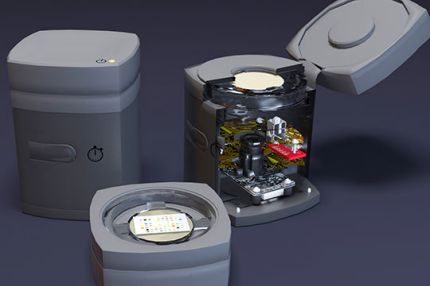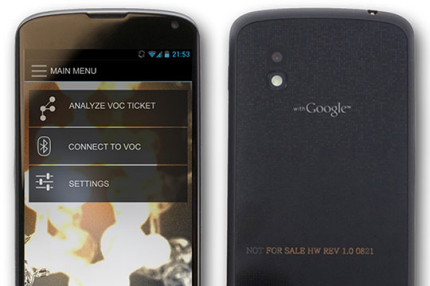Army develops smartphone system to detect chemical, biological threats
The system would allow soldiers to identify potential threats on the spot.

After a sample is taken, VOC strips are loaded into the Biotouch device.
Soldiers facing a situation with a potential biological or chemical threat could soon have a way to assess the threat on the spot, using specially equipped smartphones.
A public/private team of researchers under the Army’s Research, Development and Engineering Command have developed Volatile Organic Compound (VOC) strips that work with a device called a Biotouch, which relays information from the VOC for analysis. The results then appear on a soldier’s Nett Warrior smartphone.
“The idea is to have two smartphones: the Biotouch that could test the VOC and the Nett Warrior phone that would receive the information from a different location,” Peter Emanuel, biosciences division chief for the Army’s Edgewood Chemical Biological Center (ECBC), said in a release. “The two will be able to communicate with each other through a phone portal within the encrypted network.”
The project is a collaborative effort by ECBC, iSense, the Army Communications-Electronics Research, Development and Engineering Center, and the Defense Threat Reduction Agency.
At the heart of the project are the VOC strips, colorimetric sensor assays that each are about the size of a postage stamp and have 88 indicator dyes—specific to defense purposes—developed by iSense. When faced with a potential threat, a soldier could use a strip to take an environmental sample, such as soil, or biomedical sample, such as urine, ECBC said.
The strip is then loaded into the Biotouch, a 3-by-3-by-5-inch device that doesn’t look much like a smartphone but has the ability to geo-tag the strip and connect to the Army’s network. The soldier can then retrieve the results on a Nett Warrior phone, a Samsung Galaxy Note II adapted for military use.
ECBC engineers are developing the Biotouch colorimetric assay reader using 3D printing, designing it, like the Nett Warrior phone, to allow for easy software upgrades. CERDEC is designing the Nett Warrior interface.
Researchers said the two-piece CB (chemical/biological) mobile detection system worked better than some technologies that required only a smartphone. Some mobile detectors that attach to a smartphone enable it to be used as a microscope or assay reader, but the phones ECBC tested with those readers weren’t rugged enough for military use and often relied on commercial cellular networks, so the information wasn’t protected. The Biotouch and Nett Warrior phones are rugged enough for use in-theater, band use the Army’s encrypted network.
Those detectors also required the user to stay at the site of the biological or chemical sample during the analysis, which could be dangerous. With Biotouch and Nett Warrior, a soldier can collect a sample on the VOC strip and then move a secure area for the analysis.

The Nett Warrior phone has a reader app to get test results.
Researchers expect to have prototypes of the system ready by May for use in two projects: the Joint United States Forces Korea Portal and Integrated Threat Recognition advanced technology demonstration, and a medical countermeasures project with the Telemedicine & Advanced Technology Research Center.
Eventually, the technology could be adapted for a variety of uses, both within and without the Defense Department, Emanuel said. The Food and Drug Administration could use it for food inspections, for example. Hospitals, first responders and Customs and Border Protection also could make use of it.
“There are so many more possibilities for this type of technology, and I’m glad that we’re building it for the Army,” he said.
NEXT STORY: Army plans its largest solar array to date




